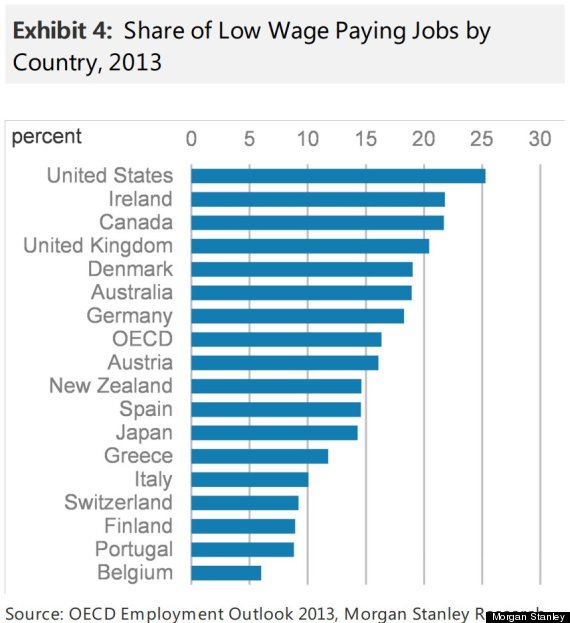MASSIVE MIDDLE-CLASS DECLINE.
CONTEMPLATING A BROKEN BUSINESS MODEL—WHICH WE DON’T SEEM TO BE TRYING TO FIX
“The vast majority of Americans, at all coordinates of the economic spectrum, consider themselves middle class; this is a deeply ingrained, distinctly American cognitive dissonance.”
Ellen Cushing“A smaller government reflecting the needs of the middle class and poor is superior to a big government reflecting the needs of the privileged and powerful.”
Robert Reich“Watching middle-class conservatives vote for politicians who've proudly pledged to screw them and their children over fills me with the same exasperated contempt I feel for rabbits who zigzag wildly back and forth in front of my tires instead of just getting off the goddamn road.”
Tim Kreider, We Learn Nothing



It has taken a truly amazing length of time for people to wake up to the plight of the American Middle Class. Things started to go wrong for the Middle Class back in 1973. A recent report by the Center for American Progress reflects an even worse situation that I had thought (and what I thought was bad enough).
Let me quote from the CAP report.
The Cost of Key Pillars of Middle Class Security Has Risen By $10,600 Since 2000
We often write about the challenges income inequality poses in helping the middle class get ahead: the wealthiest are taking a bigger and bigger share of income while for most people, wages are stagnating. But there is another side to this equation: the cost of making ends meet is rising fast too, and maintaining a middle-class quality of life is rising along with it. A breakthrough new report by the Center for American Progress analyzes these costs, as well as stagnant incomes, to demonstrate just how much the middle-class has been squeezed this decade.
CAP’s analysis, “The Middle-Class Squeeze,” shows that for a typical median income married couple with two children, the collective cost of basic pillars of middle class security — including child care, higher education, health care, housing, and retirement –rose by an estimated $10,600 between 2000 and 2012. At the same time, incomes have flattened. For this typical family, acquiring middle-class security cost 30 percent more between 2000 and 2012, but they earned less than one percent more.
The report goes into detail about each pillar and recommendations for how alleviate the squeeze, and here some of the key findings:
- Jobs: Improving our lackluster jobs picture is the first task to address the middle-class squeeze. That means boosting demand by putting money back into the pockets of hard-working Americans. It also means investing in education and workforce-development programs, strengthening unions, and ensuring basic workplace protections to maximize workforce participation.
- Health care: Health care costs for families have risen dramatically, from $11,790 total to over $20,000. An average family of four’s premium and out-of-pocket costs have on average almost doubled, from $4,600 to $8,600 per year. The Affordable Care Act has already made a difference for millions of Americans, but there is plenty more to be done to cut costs while making sure people have access to high-quality coverage.
- Child care:Child care is more expensive than median rent in all 50 states. The estimated cost of a high-quality public preschool program ranges from $6,500 to $11,000 — a cost that is simply out of reach for many families. To address this, among a number of important policies, the federal government should partner with states to provide high-quality preschool to all 3- and 4-year-olds.
- Higher education: While income is staying the same or even declining among families, the cost of higher education has skyrocketed. From 2000 to 2012, higher education costs have risen 62 percent. We must restore public investment in higher ed, through programs such as Pell grants, to help low- and lower-middle-income students.
- Housing:The cost of owning a home has risen, on average, nearly $3,000: from $10,200 to $13,000 per year. Half of renters spend over 30 percent of their income on rent. New mortgages are at a 17-year low, with many middle-class families locked out of the market.
- Retirement: While the costs of other essentials increase, it is no surprise that saving for retirement has become much more difficult for those in the middle class. Now, approximately half of all American households in danger of having insufficient savings for retirement.
These middle class pillars are driving how much Americans can spend on other more basic things as well. CAP’s report found that as a result of this middle-class squeeze, a typical middle-class family had $5,500 less for basic necessities like groceries, clothing, and emergency savings by 2012, compared to 2000.
BOTTOM LINE: The United States’ middle class used to be the world’s wealthiest. But the combination of stalled income and rising costs for essential pillars of middle class life have made that no longer the case. Middle class families are the driver of economic growth in this country. But now the middle class is being squeezed, and squeezing American opportunity and economic growth along with it.

No comments:
Post a Comment